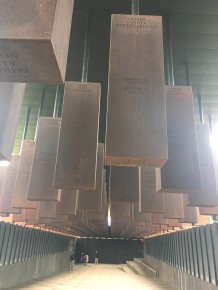The Legacy Museum and Memorial
 In Montgomery, Alabama, I visit the Legacy Museum, where for the first time in my life I start to learn the full truth of the African-American experience, not just in slavery but from the Civil War to 1965: mob violence, Black Codes, Convict Leasing, lynching, institutionalized suppression through Jim Crow laws, and abuse through manipulation of the criminal justice system. I was speechless.
In Montgomery, Alabama, I visit the Legacy Museum, where for the first time in my life I start to learn the full truth of the African-American experience, not just in slavery but from the Civil War to 1965: mob violence, Black Codes, Convict Leasing, lynching, institutionalized suppression through Jim Crow laws, and abuse through manipulation of the criminal justice system. I was speechless.
The subjugation of blacks across the entire South, aided by inaction in the rest of the country, enabled an ever-evolving white supremacist caste system to perpetrate itself for one hundred years. I’m stunned that I never had a full understanding of this and that our educational systems and public discourse have largely ignored it. I finally begin to grasp what generations of African-Americans went through—and the deep, destructive legacy it has left to the present.
I go on to the National Memorial for Peace and Justice, where I walk amid 805 steel rectangles the size of coffins—one for every county or parish in the Southern states, and they all had lynchings. Some have only one or two names or “unknown” victims. Others have more than fifty. Altogether, decade after decade, thousands and thousands were lynched.
I weep. Again and again.
I’m shocked that my own current home area of Caddo and Bossier Parishes in Louisiana were among the very worst places for lynching. I am shocked again to find that lynchings even took place in the other states where I’ve lived—Minnesota and California.
I celebrate the tremendous changes since the early twentieth century—and I grieve the evils that were part of this nation’s history, including the lingering legacy of racism that you cannot fully understand until you live in the South.
This draws me deeper into embracing the African-American experience, and it increases my intolerance of real racism—as opposed to the political way too many people mindlessly label others as “racist.”
This experience also draws me deeper into the heart of God and how God’s Spirit works before, beneath, above, and beyond us all—especially among those who acknowledge Him. After all, what was at the center of the Abolition Movement and at the center of the Civil Rights Movement? The church. And in the church the Spirit of God was at work, and still is.
“There is neither Jew nor Greek, slave nor free, male nor female, for you are all one in Christ Jesus” (Galatians 3:28).
If you ever in your life have a chance to see this place, I recommend you do so. See https://eji.org/








Thank you so much for sharing this. I was not aware that this museum existed. I have never been to Montgomery and don’t expect I will ever have the opportunity to go, but should something supernatural happen to make a way, I would definitely visit it. Just reading about slavery and the racial issues that followed can only give you a very imperfect understanding of what it was and is like to live there in the past and present. The treatment of these people has been worse than inhuman, and I have no reference point to help me understand why and how it happened. I only know it makes me angry to think that people can be that cruel. But I also know that satan had the upper hand in this issue before the church stepped in to bring at least partial redemption to the situation.
Diane,
Thank you for your comment. The Legacy Museum and the National Memorial were just opened last April 2018. You can learn a lot of what they have on http://www.eji.org.
Hello Peter,
I just read your blog and I will never understand why people only see the skin color of others. Am I to naive to think that skin color doesn’t matter? I do not see what difference it makes, Louisiana is still stuck in the slavery times. On both sides, whites think the are supreme and African Americans seem to think they don’t have rights. I know that my view is very limited and I don’t know much, but I do know that often student at school do not know about their heritage, the reason for black history, they do things and don’t know where they originated. It is hurting my heart to see and hear them, but I also feel inadequate in how to change this kind of thinking.
Michaela